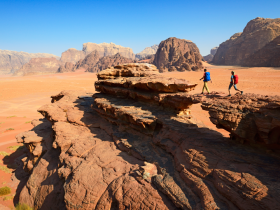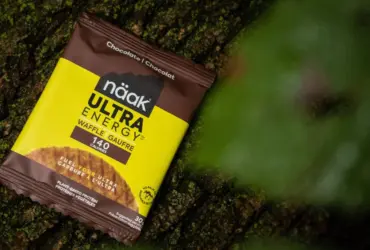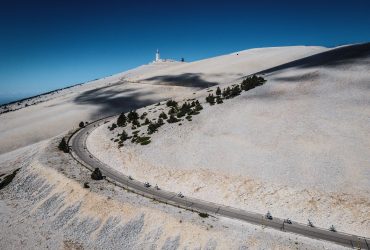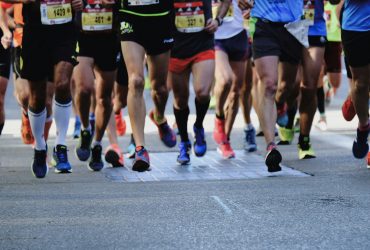Adventurous mountain biker, Cédric Tassan went to Kazakhstan for a 600 km trip in majestic landscapes. Discover his account of this epic journey, from the shores of the Caspian Sea to the last Kazakh rock fortresses.

"The Mangystau region is located in south-west Kazakhstan, east of the Caspian Sea. With just over 600,000 inhabitants for 165,000 km², this region has one of the lowest population densities in the world. But behind these vast stretches of desert lie some absolutely fantastic landscapes. Looking at all these stones, you'd think mankind had always shunned this region. And yet, from the fascinating underground mosques to the exploitation of the subsoil's resources, the Mangystau has always attracted mankind. It was in this part of the world that Cédric Tassan decided to carry out an integral traverse of over 600 km from west to east, from the shores of the Caspian Sea to the last rocky fortresses.

I started working on this destination in late 2019. I had gone to see an exhibition near my home by an adventurous photographer and immediately fell in love with the landscapes. The pandemic came and went, putting the brakes on any travel to Kazakhstan. This allowed me to have time to document and map out my route. Because when I contacted the locals, they all advised me against coming here by bike alone. It is an inhospitable desert, without water, without living souls. However, I am not discouraged and continue my research. While working on aerial views, I see that the tracks traced by the vehicles are numerous. This means that there is a lot of traffic! By searching well, I find houses scattered in the middle of nowhere, alignments, yurts. In short, life! I build an itinerary where each evening I manage to find supplies. But the more I go down in the desert, the less I meet villages or houses...

Therefore, for such an adventure, you need a lot of equipment to carry. I have several bikes in my garage and I have to make a choice. My Kern EN is a big bike, more adapted to technical descent than to long distance in the desert. It will stay in France. My Venture would be the ideal companion, it's a gravel bike made for wide open spaces and wide trails. However, even if the Mangystau doesn't have much relief, I don't know what kind of surface I'll have. I'm afraid I'll be more than tired on the rough roads. The one that seems to be the most suitable is my Shamann. It's a 10,4 kg XC: its 100 mm front and rear will bring me comfort, I can also block the suspensions to improve my performance and its tires are made to face rocks.

On the loading side, I'm going to dress it with panniers. At the front, I will fix 2 bags on the fork that will contain my water, that is 8 liters. This will allow me to last 2 days without refueling. On the handlebars, I fix my GPS and a headlight, in case I have to ride at night. I also attach 2 bags: the first one contains my night gear, the second one all my external batteries. A spare tire and a carbon tripod complete the load on the handlebars. I top it all off with an 11W solar panel. At the back, a long saddle bag contains my survival kit, warm clothes, a derailleur, a chain, a shock absorber pump. I add to that a bag under the frame with my mattress and on the top tube, a small bag that contains my repair material. I complete my bike with a water bottle holder and a mini pump. On the back, I choose an ultra light backpack and I put my camera, my drone, my first aid kit, my satellite phone, batteries, cables...

To make it worse, I am leaving in the middle of Ramadan and Kazakhstan is a Muslim country. I had not paid any attention to that when planning my adventure. But I will have to manage it because it will not be possible for me not to eat and drink during my long days of effort...

I arrive at Aktau airport. Set in the middle of the desert, this town on the shores of the Caspian Sea is the capital of Mangystau, with a population of 182,000. In the 19th century, a journey to the eastern shores of this sea was considered not only difficult but dangerous. The deserts were almost as inaccessible as the Sahara. And not just because of the harsh climate or lack of vegetation, or even because of the scorching winds that kick up dust storms. The problem was that there was no drinking water. In 1850, the great Ukrainian poet Taras Shevchenko, exiled here by the Russian government, wrote: "A desert without any vegetation - only sand and stones. You'd look around and feel so sad you might as well hang yourself." Mangystau was once called Mangyshlak a "land that has lost water". Now it's called a "land that found water". Aktau, built in the 1960s by Gulag prisoners, is the only city in the world to live entirely on seawater.

I am welcomed by Yersultan, my local contact from Ata Trip. We have been talking for several weeks and he took care of some of my logistics. And in particular to find me accommodation in local people's houses during my crossing. As agreed, we take the direction full north. The extreme monotony of the landscape and the dryness which reign here impress me. For the moment I am sitting in an air-conditioned vehicle but in a few times, I will be left to myself. After several hours of driving, we arrive at the end of Mangystau, on a rocky plateau overlooking the Caspian Sea. It is time to unload the equipment and prepare my bike. Yersultan brought me water and food for tonight and tomorrow. My first night is going to be done here, like an armed vigil. The car moves away, I remain alone here with the Caspian Sea in sight. From now on, there is no more human noise, only the wind fills the immense emptiness that I feel here. In order not to sink into an inner panic, I have to occupy my mind: check my load, take some pictures and find a place to bivouac. I decide to leave the plateau swept by this strong wind. I know that further down I will be less exposed. Quickly, I find an old ruin, so I can put my bike against it and prepare the bivouac. For weight reasons, I did not take a tent. I tell myself that in the desert, it should not rain often...
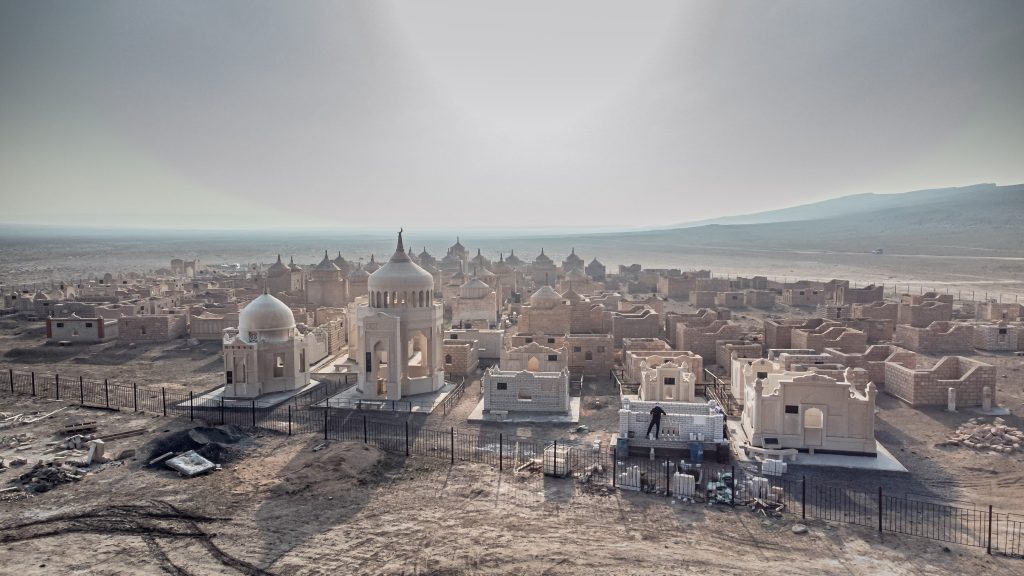
I sink into my comforter under a heavy sky. No luck, in the middle of the night, I am awakened by a light rain. I decide not to move. But quickly, it becomes more important, I quickly take refuge under my poncho, the down soaked... I wait that that passes and decide to make my camp again in the light of the full moon. I dry my mattress and put my poncho on my sleeping bag. In case of rain, I will only have to fold it on my head and to keep quiet... A second shower comes to disturb my night, I shiver of cold. But stunned by the fatigue, I wake up around 7am !

I attack my crossing by making my way on the numerous tracks traced by the 4×4. While descending from the plateau, I meet my first necropolis in the middle of the desert, a magic moment to see these magnificent mausoleums. A 4×4 comes to meet me, it is my first contact with the locals. The roads are multiple, a real labyrinth, fortunately my GPS is there to guide me. My itinerary gets closer to the Caspian Sea. I am called from far by a group of men busy near big rocks, they are 4 fishermen: 2 Kazakhs and 2 Russians. I am invited to share the grilled fish caught a few minutes ago.

After 35 km on the bike, I cross a canyon and discover my first troglodyte mosque opposite. I enter the Shakpak Ata site. The mosque was built 1,000 years ago. The name was given in honor of the Sufi Shakpak-Ata, a Kazakh sage-healer who lived here with his disciples. The interior space surprises visitors with its purest whiteness, as the hall is carved out of the chalk cliff. You immediately feel the special atmosphere of the ancient sanctuary. Around the mosque, numerous tombstones lie. The story goes that they belong to disciples of Shakpak-ata. And it's not known exactly where the Sufi was buried. You have to wander here with caution and pay particular attention to each tomb. Another 35 km of desert and, at the end of the day, I come upon the small town of Taushik, surrounded by sand. I ask for Nurzhan Akim's house, as he's supposed to welcome me this evening. A truck and a horde of small motorcycles escort me to his home. On this beautiful evening, we all dine as a family, with food in abundance.

I leave early the next day and the first 15 kilometers of asphalt serve as a warm-up. When I leave the road to go east through the desert, I find myself facing the wind. I feel that the day is going to be hard because until the end I will go in this direction. The monotony sets in, the landscape flat and bland. Only some camels emerge from the horizon. Little by little round rocks dot the steppe. After a last climb, I find a magnificent valley where these balls of rocks are more than 3m in diameter! I make my way through this vast field of sedimentary rocks formed 150 million years ago. In the center of these spheres are shells, fish teeth and bones and plant remains. This is the proof that Mangystau is indeed a land that has lost water. I still struggle against the wind, cross a huge salt lake and meet a new road. I am happy to find the tar, the progression will be facilitated. Further on, I discover the magnificent rock of Sherkala, a majestic mountain in the shape of a yurt. After a detour of a few kilometers to better appreciate it, I continue to the camp of Etno el Kogez. I spend my night in a peaceful yurt, ready to face the following even if I receive an SMS alert on my cell phone announcing a wind storm in the next days.

The next day, I have 2 options: follow the road directly to my next stop or try to cross by the north through the desert. The decision is taken in a few minutes, I leave the tar and go into the unknown. The landscape is sublime this morning, I ride at the foot of a huge mountain. The wind is still blowing from the front, but the beauty of the place makes me forget the effort. Further on, I meet a deserted camel farm. The track slopes north and forces me to cross a long sandy area: I have to push. Further on, I climb on a ridge, get some height and quickly find myself without a path. I trace straight ahead, crossing several steep canyons then find a new track. I keep on pulling due east in the face of an increasingly strong wind. I painfully reach Zjamysh, a small village in the desert. Same cinema as in the previous village, a horde of motorcycles escort me to Masqat's house. His family is very religious and respects Ramadan to the letter. In the evening everyone is gathered around a good table to whet their appetite with many small dishes. But the traditional meal, the besbarmak, comes a little later, laid out on mats on the floor. We eat with our hands the meat, boiled legs, potatoes and onions. At the end of the meal, the sorpa, a meat broth is served. Filled, I go to bed for a short night.

From now on, I'm going into the desert and I'll have to be autonomous in food and water for 2 days. No refueling is possible. I have 160 km to go. This morning, the wind has changed, I have it on my back. I might as well say that the 40 km of tar are done very quickly. Then it's time to leave the road and go to the site of Sor Tuzbair: huge chalk cliffs at the edge of a gigantic salt lake. But I was quickly disappointed when I arrived there. The locals had certified me, wrongly, that there was a track to go down: I only see a vertical cliff of 100 m high and 100 km long! If I cannot go down, my adventure is compromised. Because a detour would make me lose at least 1 day on the bike and I don't have the necessary food. I spend 3 hours walking up and down this cliff and finally find a very steep passage in a labyrinth of very steep chutes. I have to dismantle my panniers and go back and forth several times to get to the bottom. Satisfied with this discovery, I also know that the trap is closing on me. Impossible to turn back, I will have to go forward at any cost. The night at the foot of these magnificent cliffs and against a boulder is one of the best I have ever spent outside.

The next day, I start very early and go straight through the huge salt lake! I navigate at sight, without following any track. But the closer I get to the center of the lake, the more the ground slips under my crampons. The fear of getting stuck in this clay makes me stay careful and turn off very quickly in case of an alert.

After 40 km, I leave the salt lake and find a railroad and a small building. I lie down on a cement slab and allow myself a good snack and a nap. I continue my crossing of the desert and at the end of the day, I reach after 80 km totally alone the religious site of Shopan ata, a magnificent necropolis and a troglodyte mosque. After the visit of the place, I enter the buildings which welcome pilgrims and visitors. Here one finds lodging and covered free. This site is like an oasis in the desert. There is no other village nearby. I spend the evening in the company of the locals, trying to follow the traditions as well as possible. In the dormitory where we sleep on the ground, the night is agitated, noisy. The comings and goings between the dining room and the room are incessant. During Ramadan, Kazakhs get up at night to eat. Finally towards 5h30 of the morning, I decide to prepare to leave, I cannot sleep any more. I leave Shopan Ata at night and turn on my headlights to follow the brand new road built 3 years ago. After 70 km, I reach another necropolis, Beket Ata and take 2 hours to visit it.

The continuation of my journey is only dazzling! Because I discover the spectacular site of Boshzira, which is without any doubt for me, the most beautiful landscape that I could see on earth! Where the rocky plateau stops, it gives way to an immense plain from which rocky needles emerge. The geology has shaped a totally incredible and immense landscape. I ride in a master canvas during a whole day, fighting also with the sand which becomes more and more present. My last stop is in the lost village of Ak Kuduk. Here, no road, the first city is 5 hours away by 4×4! I am welcomed with warmth by the locals. In my memory, nobody has ever seen a bike arrive here. People live from little, some camels, some goats, that's all. Zhandarbek wishes to host me for the night, I don't say no. We spend a memorable evening in the laughter with his wife and children.

It smells like a stable, I've still got 80 km to go to complete my crossing. Because beyond the point I've set myself, there's nothing left. These are the last rocky lines and above all the border with Turkmenistan. I absolutely must not cross it as I have no visa. But the Mangystau doesn't want to release me any time soon. One sand dune follows another, I have to push my bike regularly and the wind blows head-on. After passing a military garrison, I reach a small lagoon where a pretty river flows! Water in the middle of the desert! Just then, Yersultan and the driver join me. I know that nothing can stop me now. The 4×4 opens up the track for me, but I let it go far enough away to preserve my isolation. A long climb, the longest of my entire journey, concludes my 630 km adventure. At the top, it's a slap in the face! I arrive where the earth stops, where the rocks emerge from the clouds. The landscape is breathtaking: an immense salt lake opens up before me, from which monumental cliffs emerge: Karynzharyq will be the last of Kazakhstan's fabulous landscapes to remain engraved in my memory".
Text: Cedric Tassan / Instagram: Cédric Tassan
Photos : Cédric Tassan / Ruslan Churov







